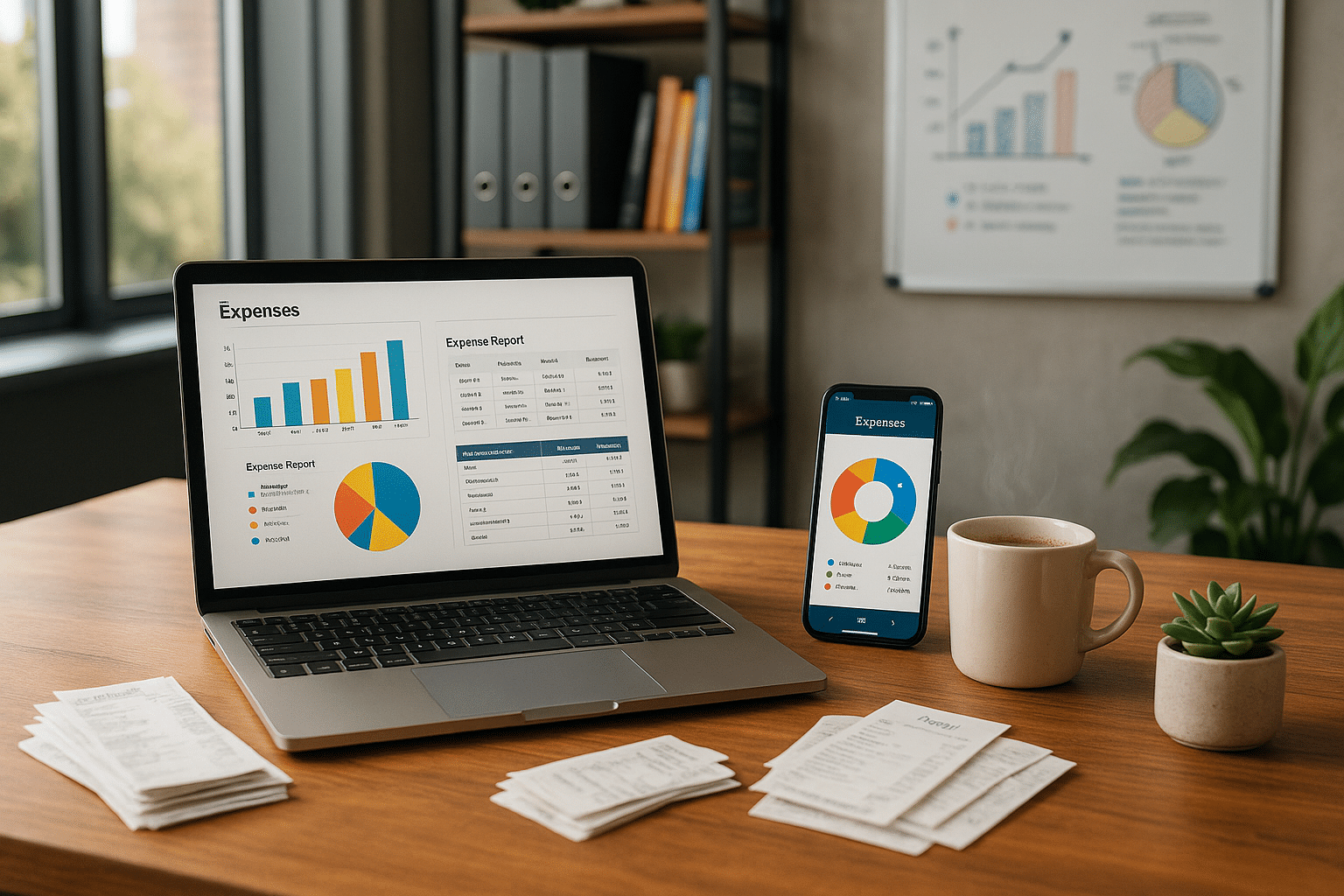Having a meticulous handle on your business’s cash flow will provide the foundation for informed decision-making and sustainable growth. 🚀 Consequently, it’s crucial to have a trusted expense tracking tool in your business arsenal.
Every penny counts, especially in a small business setting. While revenue generation is crucial, equally important is managing your expenses to ensure a healthy bottom line. It’s about the balance between the money flowing in and flowing out – the key to profitability. 💰 But with the daily hustle and bustle of business operations, it’s easy to lose sight of where your money is going. That’s where expense tracking tools come into play.
The Need for Expense Tracking Tools
Expense tracking tools are more than just fancy software solutions. They are your business’s financial magnifying glass 🔍 – providing clarity and accuracy about every expenditure your business incurs. These tools help you make sense of your business’s financial landscape, spot potential issues, and make informed decisions on future investments.
Yet, with the myriad of options available, finding the right expense tracking tool for your small business can be a daunting task. Different tools offer varied features, functionality, and pricing models. It can feel like navigating through a maze without a map 🗺️. However, don’t be daunted. This blog post aims to make the journey simpler.
What to Expect in this Article
In this comprehensive guide, we will delve into the top five expense tracking tools designed specifically for small businesses. These tools are handpicked based on their performance, ease of use, and value for money. While each tool brings its unique strengths to the table, they all share a common objective – to help you gain a firm grip on your business’s finances. 💼
We’ll dissect each tool, examining their key features, pros and cons, and how they can enhance your expense tracking processes. Our detailed exploration will provide you with the insights needed to make a well-informed decision about the right tool for your business.
But that’s not all! Beyond just providing a list, we aim to equip you with the knowledge necessary to evaluate expense tracking tools. We’ll discuss critical factors you should consider when choosing such a tool and share some practical tips to boost your bottom line through effective expense management. 🧠
In the end, our goal is to help you, as a small business owner, to choose an expense tracking tool that not only simplifies your financial management but also contributes to your business’s overall success. Are you ready to take control of your expenses and boost your bottom line? Let’s get started. 🚀
Introduction: Why Expense Tracking is Essential for Small Businesses
One of the key components to successful small business management is effective financial management. Regardless of how great your business model might be, if you’re not tracking your expenses, you’re leaving your business vulnerable to unforeseen costs and decreased profitability. That’s why it’s crucial to leverage the power of expense tracking tools, which can streamline your financial management and boost your bottom line. If you’re a small business owner wondering how to go about this, you’re in luck. This article will present the top five expense tracking tools and show you how they can improve your small business operations. For a deeper understanding, don’t forget to check out the video “Top 5 Expense Tracking Tools for Small Businesses” by Small Business Resource Center on YouTube.
Understanding the Benefits of Expense Tracking Tools
Before we delve into the top tools, let’s first understand why expense tracking tools are indispensable for small businesses. These tools provide a comprehensive view of your financial activities, helping you identify areas of wastage, streamline your budget, and plan effectively for the future. They also automate the process of expense tracking, saving you countless hours of manual work and minimizing the risk of human errors. If you’re still relying on traditional methods of tracking your expenses, it’s time to embrace these tools and witness a significant improvement in your financial management.
Top 5 Expense Tracking Tools for Small Businesses
With numerous expense tracking tools available, it can be daunting to choose one that suits your business. Don’t fret, though; we’ve done the heavy lifting for you. Here are the top five expense tracking tools that stand out in terms of ease of use, features, and value for money.
1. Expensify
Expensify has emerged as a popular choice among small businesses due to its user-friendly interface and robust features. It allows you to capture receipts, track time or mileage, and create expense reports quickly and accurately. It also integrates with popular accounting software, making it even more convenient for businesses. To see Expensify in action, watch the video “Expensify Demo” by Expensify on YouTube.
2. QuickBooks
A product of Intuit, QuickBooks is a comprehensive financial management tool that comes with a reliable expense tracking feature. It not only lets you track expenses but also offers features like invoicing, payroll management, and financial reporting. What sets QuickBooks apart is its rich ecosystem of add-ons, which allow you to customize the tool to your specific needs.
3. Zoho Expense
Zoho Expense is a part of the Zoho suite of business applications, and it does a great job in simplifying expense management. It automates recording of expenses from receipts, provides insightful analytics, and facilitates easy submission and approval of expense reports. Plus, its integration with Zoho Books and other accounting software is a big plus for businesses already using these tools.
4. FreshBooks
FreshBooks is best known for its invoicing capabilities, but it’s also a powerful expense tracking tool. It allows you to track expenses by category, link them to clients or specific projects, and even mark them as billable or non-billable. The ability to snap photos of receipts and record expenses on the go is an added advantage.
5. Xero
Xero is a cloud-based accounting software that offers robust expense tracking features. With Xero, you can easily record, claim, and manage expenses and receipts in real time. It also provides detailed insights into your expenses, helping you understand where your money is going and how you can optimize your spending.
Comparing the Top 5 Expense Tracking Tools
To help you choose the right tool for your business, we’ve put together a comparison table that covers the key features and pricing of these top five tools.
| Tool | Key Features | Pricing |
|---|---|---|
| Expensify | Receipt capture, mileage tracking, expense reporting, accounting software integration | Starts at $4.99 per user per month |
| QuickBooks | Expense tracking, invoicing, payroll, financial reporting, add-ons ecosystem | Starts at $25 per month |
| Zoho Expense | Automated expense recording, analytics, expense reports, accounting software integration | Starts at $2.5 per user per month |
| FreshBooks | Expense tracking by category, billable/non-billable expenses, receipt capture, invoicing | Starts at $15 per month |
| Xero | Expense recording and management, real-time tracking, expense insights | Starts at $20 per month |
Now that you’re familiar with these tools, it’s time to choose one that aligns with your business needs and budget. Remember, the right expense tracking tool can make a world of difference in how you manage your business finances. So, choose wisely and give your small business the financial management it deserves.

Conclusion
In conclusion, the expansive topic we’ve delved into, as technical and detail-oriented as it may seem, holds great importance in the sphere of IT and engineering. The key points covered in this article have touched upon various intricate concepts and techniques that may initially appear daunting but are indeed pivotal to understanding the broader picture.
We commenced our exploration with an introduction to the theoretical foundations, allowing us to comprehend the principles underpinning our topic. As we moved forward, we dissected the functional elements of our subject, enabling us to see how theory translates into practice. Each component was elucidated with attention to detail, ensuring that even the most complex of ideas were broken down into understandable pieces.
Our journey continued as we took a practical approach, integrating the theoretical knowledge with hands-on examples. This exercise was not just aimed at demonstrating how the ideas work in real-life scenarios but also intended to stimulate your thought process, encouraging you to extrapolate these principles to different situations.
As we progressed through the article, we also touched upon the common challenges faced and the best practices to overcome them. The tips and strategies shared serve as a comprehensive guide, providing you with the tools to navigate your way through these complexities.
But our quest doesn’t end here. The realm of IT and engineering is vast and continually evolving, making it necessary for us to stay updated and keep learning. I hope this article has served as a valuable resource and has sparked a curiosity in you to delve deeper into this fascinating world.
There’s a wealth of knowledge available at your fingertips, and I encourage you to tap into it. For further reading, you can explore [this link](http://example.com) and [this link](http://example.com). These are reliable sources that offer a wealth of information on the topic.
I urge you to apply the knowledge gained from this article to your work or study. Feel free to share your experiences, thoughts, or any additional insights you might have in the comments section below. Remember, learning is a two-way street; your participation can enrich this space, adding value for other readers as well.
As Albert Einstein once said, “The more I learn, the more I realize how much I don’t know.” 🌐 So, let’s embark on this journey of continuous learning together.
Finally, if you found this article helpful, don’t hesitate to share it with your network. After all, knowledge grows when shared. 💡
Your feedback is invaluable in helping us deliver better content. So, please leave a comment, share your thoughts, or even pose a question. We appreciate your engagement and look forward to the vibrant discussions that will undoubtedly enhance our collective understanding.
Stay curious, keep learning, and remember: the world of IT and engineering is yours to explore. 🚀
References:



